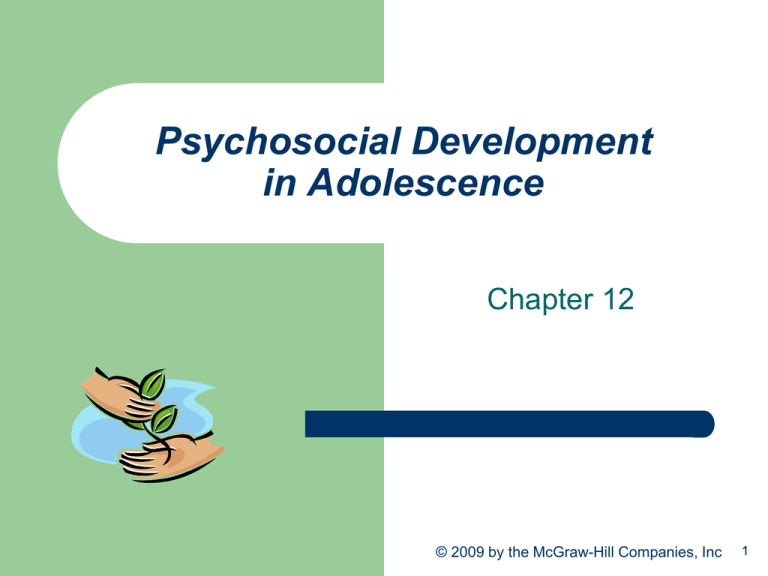
Psychosocial Development
in Adolescence
Chapter 12
© 2009 by the McGraw-Hill Companies, Inc
1
Guideposts for Study
How do adolescents form an identity, and what roles do
gender and ethnicity play?
What determines sexual orientation, what sexual
practices are common among adolescents, and what
leads some to engage in risky sexual behavior?
How do adolescents relate to parents, siblings, and
peers?
What are the root causes of antisocial behavior and
juvenile delinquency, and what can be done to reduce
these risks of adolescence?
© 2009 by the McGraw-Hill Companies, Inc
2
Erikson’s Crisis of
Identity versus Confusion
Struggle to become an adult with unique
sense of self and role in society
–
–
Adolescence provides psychosocial
moratorium, or ‘time out’ period to explore
identity
However, seldom fully resolved in
adolescence
© 2009 by the McGraw-Hill Companies, Inc
3
Resolving Erikson’s Identity Crisis
Successful resolution leads to ‘fidelity’
–
–
Feeling of belongingness to friends or
family
Identification with a set of values
The danger is identity confusion
–
Although some degree of confusion is
normal
© 2009 by the McGraw-Hill Companies, Inc
4
Components of Identity
Adolescents attempt to resolve three issues:
1. Choice of occupation
2. Adoption of values
3. Development of sexual identity
© 2009 by the McGraw-Hill Companies, Inc
5
Marcia: Identity Status
Identity Achievement
Crisis leading to commitment
Foreclosure
Commitment without crisis
Moratorium
Crisis with no commitment yet
Identity Confusion
No commitment, no crisis
© 2009 by the McGraw-Hill Companies, Inc
6
Identity Formation:
Gender Differences
Role of relationships
–
–
Do females develop a sense of self through
forming relationships? OR
Is identity a struggle for independence and
connectedness, regardless of gender?
Self-esteem
Do girls have lower self-esteem than boys?
© 2009 by the McGraw-Hill Companies, Inc
7
Four Stages of
Ethnic Identity
For many young people in minority groups,
race or ethnicity is central to identity
formation.
1. Diffuse
2. Foreclosed
3. Moratorium
4. Achieved
© 2009 by the McGraw-Hill Companies, Inc
8
Racial/Ethnic Identity
Connectedness to one’s ethnic group
Awareness of racism
Embedded achievement
Cultural socialization---parental practices that
teach children about racial or ethnic heritage,
promote cultural customs & traditions and
cultural pride
© 2009 by the McGraw-Hill Companies, Inc
9
What is
Sexual Orientation?
Focus of consistent sexual, romantic,
and affectionate interest
–
–
–
–
Homosexual – persons of same sex
Heterosexual – persons of opposite sex
Bisexual – persons of both sexes
Isolated experiences do not determine
orientation
© 2009 by the McGraw-Hill Companies, Inc 10
Biological Views of
Sexual Orientation
Conclude orientation is, at least in part,
genetic – moderately heritable
–
–
–
–
Size of hypothalamus
Pheromone studies
Gender-atypical behavior in childhood
Differences in sexual arousal
© 2009 by the McGraw-Hill Companies, Inc 11
Homosexual or
Bisexual Identity
Gay, lesbian, or bisexual adolescents often
feel isolated in a hostile environment.
–
There is no association between homosexual
orientation and emotional or social problems
…apart from those caused by societal treatment
of homosexuals.
Sexual identity becomes more complex and
follows a less-defined timetable.
© 2009 by the McGraw-Hill Companies, Inc 12
Sexual Behavior
Average age at first intercourse
–
–
Females: 17 years
Males: 16 years
Top reasons for NOT having sex:
–
–
Religion or morals
Not wanting to get (or get a girl) pregnant
© 2009 by the McGraw-Hill Companies, Inc 13
Factors Associated
with Early Sex
Early puberty
Poverty
Poor school performance
History of sexual abuse
Neglect
Cultural or family patterns
Perception of peer norms
© 2009 by the McGraw-Hill Companies, Inc 14
Use of Contraceptives
Who uses contraception during first
intercourse?
–
–
83% of girls and 91% of boys
The older a girl is at her first intercourse, the
greater the likelihood she will use protection
Best safeguard is condoms
–
Protection against STDs and pregnancy
© 2009 by the McGraw-Hill Companies, Inc 15
Where do Teens get
Information about Sex?
Friends
Parents
Sex
education at school
Abstinence only debates
Media
© 2009 by the McGraw-Hill Companies, Inc 16
What Type of
Sex Education Works?
Works
Programs that encourage abstinence AND
discuss STD prevention and safe-sex practices
Delay initiation & increases contraception use
Does Not Work
Abstinence Only/Virginity Pledges
Do not delay initiation
© 2009 by the McGraw-Hill Companies, Inc 17
STDs and Pregnancy:
Risks of Adolescent Sex
Teens at highest risk :
–
–
–
–
Younger
Multiple partners
Not regularly using contraception
Misinformed about contraception
© 2009 by the McGraw-Hill Companies, Inc 18
Sexually Transmitted
Disease (STD) Prevalence
About 1 in 4 new cases in the U.S. occurs
among 15-19 year olds
Prevalence in teens due to:
–
–
–
Early sexual activity
Failure to use condoms or use them correctly
Tendency for girls to have older partners
© 2009 by the McGraw-Hill Companies, Inc 19
Most Prevalent STDs
HPV
Trichomoniasis
Genital Herpes Simplex
Chlamydia and gonorrhea (both
curable)
© 2009 by the McGraw-Hill Companies, Inc 20
Teens and HIV
Of 4.1 million new infections, about half are
in young people 15-24 years old.
In the U.S., 1 in 4 people living with HIV were
infected in their teenage years
Early detection important
© 2009 by the McGraw-Hill Companies, Inc 21
Teenage Pregnancy Trends
© 2009 by the McGraw-Hill Companies, Inc 22
Traits of Teen Mothers
Many are sexually inexperienced
Many grew up without a father
Likely as children to have been abused
and/or exposed to parental divorce
Likely exposed to substance abuse
Likely exposed to family member with
mental illness or criminal behavior
© 2009 by the McGraw-Hill Companies, Inc 23
Teenage Parents
Teen mothers at risk for:
–
–
–
Dropping out of school or being poorly
educated
Financial hardship
Additional pregnancies
Teenage fathers
–
Limited financial resources, poor academic
performance and high dropout rates
© 2009 by the McGraw-Hill Companies, Inc 24
Children of Teenage Mothers
At increased risk for:
–
–
–
–
–
Prematurity and low birthweight
Fetal, neonatal or infant death
Health and academic problems
Abuse and neglect
Developmental disabilities
© 2009 by the McGraw-Hill Companies, Inc 25
Preventing Teenage Pregnancy
What are U.S. rates so high?
Reduced stigma on unwed motherhood
Media glorification of sex
Lack of clear message about sex and parenthood
Childhood sexual abuse
Failure of parents to communicate with children
Less contraceptive use
Requires multifaceted solution
© 2009 by the McGraw-Hill Companies, Inc 26
Is Adolescent
Rebellion a Myth?
Stereotype of adolescent rebellion:
–
–
–
–
–
A time of emotional turmoil
Conflict within the family
Alienation from adult society
Reckless behavior
Rejection of adult values
Only 1 in 5 teens fits this pattern
© 2009 by the McGraw-Hill Companies, Inc 27
Adolescent Use of Time
US teens have a great deal of discretionary time.
Time with family members declines dramatically.
More time is spent alone and with opposite sex.
Weekend partying is common for older teens.
African-American teens spend more time with
family than white teens.
© 2009 by the McGraw-Hill Companies, Inc 28
Adolescents and Family Conflict
Individuation—adolescent’s struggle for
autonomy and personal identity
Most arguments over day-to-day matters:
–
–
–
–
–
–
Chores
School work
Dress
Money
Curfew
Dating, friends
© 2009 by the McGraw-Hill Companies, Inc 29
Factors That Affect
Adolescent Family Conflict
Parenting
style
Family structure
Mothers’ employment
Economic stress
© 2009 by the McGraw-Hill Companies, Inc 30
Adolescents and Siblings
Teens are less close to siblings than to
parents or peers
–
–
–
Less influenced by their siblings than when
younger
Become more distant from siblings throughout
adolescence
Sibling relations tend to reflect parents’
marital relationship and parent-child relations
© 2009 by the McGraw-Hill Companies, Inc 31
Adolescents Crowds
Crowds serve several purposes:
–
–
–
Help establish teen identity
Reinforce alliances
Makes it easier to make
friendships within the same group
© 2009 by the McGraw-Hill Companies, Inc 32
Adolescent Cliques
Clique - A structured group of friends
Become more common in adolescence
Membership types:
Member – ties are to one group
Liaison- ties to more than one group
Isolate – not connected to any group
Cliques can be harsh to outsiders
© 2009 by the McGraw-Hill Companies, Inc 33
Adolescent Friendships
More important than in any other life period
More reciprocal and stable than in childhood
Increased intimacy
Adolescents choose friends similar in:
–
–
–
–
Gender
Race/ethnicity
Academic attitude
Risky or problem behavior
© 2009 by the McGraw-Hill Companies, Inc 34
Adolescent
Romantic Relationships
Contribute to development of intimacy and
identity
Include risk of STDs and pregnancy
Affects quality of relationship with parents and
peers
© 2009 by the McGraw-Hill Companies, Inc 35
Two Phases of
Teen Romantic Relationships
1. Mixed groups or group dates
2. One-on-one relationships involving
intimacy
© 2009 by the McGraw-Hill Companies, Inc 36
Box 12.1 Youth Violence Epidemic
Possible influences:
–
–
–
–
–
–
Immature adolescent brain
Ready access to guns in a culture that
“romanticizes gunplay”
Presence of gangs at school
Childhood home environment
Living in unstable neighborhoods
Witnessing or being victims of neighborhood
violence
© 2009 by the McGraw-Hill Companies, Inc 37
Antisocial behavior
Tends to run in families
May have genetic base
May include neurobiological deficits
Early Onset—beginning by age 11
Late onset—after puberty
© 2009 by the McGraw-Hill Companies, Inc 38
Becoming a Delinquent
An interaction between influences:
Parental
–
–
Peers
–
Authoritative parenting may protect against
delinquency
Shaping of prosocial or antisocial behavior
Similar in achievement and social tendencies
Community
–
Collective efficacy – how do neighbors support
each other?
© 2009 by the McGraw-Hill Companies, Inc 39
Preventing Delinquency:
Intervention Programs
Offer family assistance and support
Help with interactions between home & school
Create supportive parent networks
Offer follow-up services & after-school
activities
Prevent gang recruitment
Offer adult-guided support groups
© 2009 by the McGraw-Hill Companies, Inc 40









